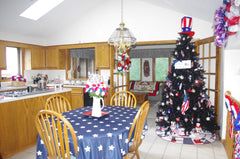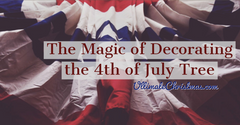How to Care for Silver Ornaments
Posted by kathy stanton on
Sterling, plated, pearls? Cleaning Christmas ornaments can be confusing. In this two part post, we look at everything that you need to know when taking on the task.

There is nothing more beautiful than a Christmas tree decorated with sterling silver stars, bells and ornaments. Timeless pieces that add a sense of quality to your Christmas decorations. Over time, however, these unique pieces could lose their shine, due to tarnish and improper storage. Not all is lost though, they can be saved. We look at some tips and tricks to keep or recover the beauty of your sterling silver heirloom ornaments.

Looking for specific information - just click on the links below:
- Quick How to steps
- How to wash silver ornaments
- How to shine and brighten silver ornaments
- How to care for silver-plated ornaments
- How to polish plain sterling silver ornaments
- How to care for lacquered sterling silver ornaments
- How to care for silver ornaments with crystals and pearls
- How to care for oxidized silver ornaments
- How to store silver ornaments to minimize tarnish

What is tarnish?
Tarnish is a natural process affecting most metals through exposure to air, moisture or other gasses. Over time a dark discoloration may occur, not great when the idea is to have a sparkling Christmas Tree. Pure silver doesn’t succumb to tarnish easily. So, why exactly are your silver ornaments tarnishing? Unfortunately, silver is far too soft to use as a material in durable heirloom Christmas ornaments. Sterling silver is often used, comprising of 92.5% silver and 7.5% other metals, usually copper. Silver-plated ornaments are also quite popular, offering the luster we love minus the price. Brass, nickel or copper can be used as a base for these ornaments, over which a very thin layer of pure silver or sterling silver is plated. The underlying or mixture of metals is what causes the tarnish. But don’t grab the aluminum foil and baking soda just yet!

When polishing is done right, ornaments can take on new life. We love how this dull piece regained its shine while maintaining enough oxidation to highlight the details.
Is it safe to clean my Silver Christmas Ornaments with DIY tips?
No! Not necessarily. There is a magnitude of DIY silver cleaning recommendations out there, but silver Christmas ornaments are special and not like silver items used as cutlery or dishes. Silver Christmas ornaments are often lacquered, painted, or embellished with crystals and pearls. Depending on the details, each ornament might need special care. Do you have Silver Christmas Ornaments with gemstones or pearls? Some of these tips could be doing more harm than good and we’ll discuss the proper way to care for these different ornaments.




A variety of beautiful pieces from Braybrook & Britten, London. Each requiring different care methods.
How to clean silver ornaments
There are many DIY tips out there on how to clean and care for your silver ornaments at home, but as we have mentioned, some of these tips could be detrimental. We look at how you should really be caring for your heirloom ornaments at home.
Identify and sort ornaments according to their embellishments
- treated silver polish cloth
- soft untreated cloth (one outside of your treated silver cloth is usually untreated)
- gentle natural fiber brush
- gentle cream polish
- plastic gloves (not natural rubber, as this can cause tarnish)
1. Dust silver ornaments before washing
Dust off your ornaments using your soft-bristled brush, or simply wipe them clean with a soft cotton cloth. Doing so will remove any particles that could potentially scratch your ornaments in later steps.
2. Wash if necessary
Use a mild unscented phosphate-free detergent to gently wash your ornaments. If an ornament has had some wax drip onto it, simply run it under warm water until it is soft enough to remove with your fingernail or your soft-bristled brush.
While washing, do not allow silver to come into contact with a metal sink, as that can cause scratching. Simply line the basin with a towel or use a plastic container. Also never risk scratching or damaging your ornaments by using a knife or sharp object to get it out.
3. Dry thoroughly
When the ornament is sufficiently clean and the wax has come off completely, dry your ornament thoroughly, and then dry some more. Don’t allow your ornaments to air dry, as this will leave unsightly watermarks. Also, if items are left to dry whilst you are polishing one item, or left in the water, this could accelerate the tarnishing process. It is best to use a soft untreated cotton cloth for drying or a cotton swab for difficult areas. Once all traces of moisture have been removed, move onto the next step - polishing.
4. Shine/Polishing
We discuss this point further here, but another wash is often necessary after using a polishing cream.
5. Give it one last wash and dry, to remove any excess polish
To remove any excess polish and ensure a beautiful finish, a second wash could be considered. Remember to dry thoroughly.
We will now look at shining and polishing in more detail. It is often in these steps where the most care should be taken.
How to shine and brighten silver ornaments
Sterling silver ornaments require very little effort to keep them beautiful and shiny. According to silver specialists Mayflower, a light polish with a treated silver cloth will often be enough. These special cloths can be bought at any specialty online store. They are usually double sided, with one side being untreated and the other treated. Use the untreated outer to shine and the treated inner to polish.
If you’re giving a silver ornament as a gift, it would be a thoughtful gesture to combine the gift with a small tub of silver polish or a treated silver polishing cloth.

We love this beautiful Tiffany & Co piece that already comes with a protective bag.
Other ornaments with lacquered or plated finishes should only be shined with an untreated cloth and should never be polished with creams or harsh chemicals. Thus, if more than a shine is needed, such as if the coating has been damaged or has worn away, you may need to consult a professional.
The American Institute for Conservation recommends that if your ornament require special intervention like repair, replating, lacquer removal, etc. you can contact an objects conservator. They will be able to offer you advice on the safest means by which to conserve and restore your special items. Visit the AIC’s page to find a qualified conservator in your area.
How to polish silver ornaments
Polishing Plain Sterling Silver Ornaments
Before we talk about polishing, it is important to note that some oxidation in the crevices could actually add character to your pieces - don’t simply remove all tarnish for the sake of it. However, depending on the extent of the tarnish and the desired look, a polishing cream can be considered. Always try to use the most gentle polish you can find, rather than a more abrasive polish. Remember that if you hear scratching noises while polishing, you could be damaging your ornaments. Use soft cotton pads or a cotton cloth while polishing.
Silver dip isn’t recommended as it strips the top layer, leaving your ornaments even more exposed to tarnish. There are also some alarming health warnings, ranging from respiratory problems to possible carcinogens, warns Jeffrey Herman of Herman Silver Restoration & Conservation in Rhode Island.

Ornaments that should never be polished or that require special care
Lacquered Silver Ornaments
Lacquer is usually applied as a clear coating, leaving the silver surface protected and as originally intended. The lacquer forms a protective clear layer over the silver ornament, and these ornaments don’t need to be polished. If these ornaments are polished with an abrasive substance, it could damage the finish and lead to dark spots.
Should lacquered ornaments get dusty, it’s recommended to hold them with a soft cloth and gently wipe the surface with a second untreated cloth. Heat is also detrimental to lacquered surfaces, so AVOID using your hairdryer to blow away dust. Once the lacquered finish is damaged, it’s a nightmare to remove or re-apply, often requiring a trained silversmith, states Spencer Marks Ltd. - leading antique silver specialists. Not sure if your ornaments are lacquered? Try remembering where you got them from, visiting the designer or manufacturer’s website should help you get the answer.

This adorable Christmas mouse ornament is silver-plated and has an ‘anti-tarnish layer’. Definitely one we won’t be polishing.
Embellished Silver Ornaments
As we mentioned earlier in the post, special care should be taken when polishing silver ornaments with crystals or pearls. You should never use strong chemical silver cleaners on these ornaments, as it may compromise the glue, dislodge the embellishments and probably destroy your pearls and gems.
Further, immersing Christmas ornaments that are decorated with pearls or opaque gemstones in some of these natural home remedies could affect their color. So the best advice, as offered by Braybrook & Britton, is to only use a soft untreated cloth for polishing ornaments with pearls and gems. If a wash is absolutely necessary, these items can be rinsed under clean running water and dried thoroughly afterwards.

This timeless mistletoe with pearls piece from Braybrook & Britton needs delicate care, to avoid damaging, discoloring or dislodging the pearl embellishments
Oxidized Silver Ornaments
Oxidized ornaments are purposely aged to have an antique look, so a light polish with a treated silver cloth will give depth by leaving the oxidized crevices untouched. Chemical cleaners are also a no go on oxidized Christmas Ornaments. These harsh substances will get into every nook and cranny, stripping them of their unique characteristics.

How to store silver ornaments
Storage is the make or break of any silver item. There are many suggestions out there, from keeping individual items in airtight plastic bags, to adding chalk to the storage boxes, but experts agree that proper storage will greatly reduce tarnish and any efforts required in the long run won’t be nearly as extensive as if you hadn’t taken any measures to store and protect your silver in the first place, so it’s worth it.
A few handy tips:
- Silver should be wrapped in dry, acid-free tissue paper, and cushioned inside cotton or shredded acid-free paper. Never wrap silver ornaments in newspaper, wool, felt or velvet.
- Storage boxes should not be made from natural wood, but rather acid-free storage material. This is due to wood’s acidic nature that could accelerate tarnishing. Ultimate Christmas Store uses high-density acid-free chipboard, that won’t encourage tarnishing and protect for longer.
- Lacquered silver doesn’t require any special storage, but it is still advised to secure and wrap these ornaments in acid-free tissue paper to protect them. If the lacquer has been damaged in any way, this would certainly prolong their shine.
- Try to add an anti-tarnish agent in your storage boxes for added protection and peace of mind. The Anti-tarnish strips from Intercept are affordable and easy to use. Simply add one to your storage box, and let them do the work. According to Intercept, these revolutionary strips react with and permanently neutralize the gases that cause the silver to tarnish.
We hope these expert tips have helped you to care for your heirloom silver Christmas ornaments. If you have any comments or feedback, we’d love to hear it! Please comment below or join our Facebook page for more expert tips and tricks on everything Christmas.
Ultimate Christmas Storage specializes in preserving Christmas ornaments for generations to come. This article offers general guidance and is not intended to be a substitute for professional advice on individual items.


